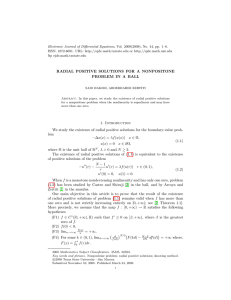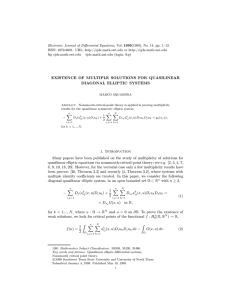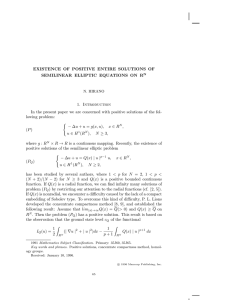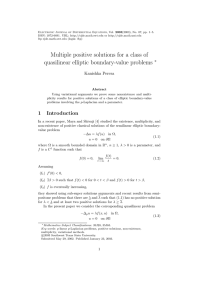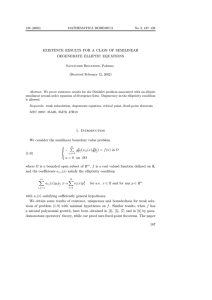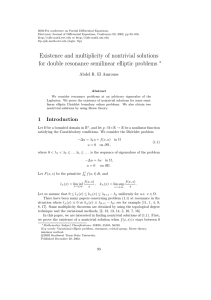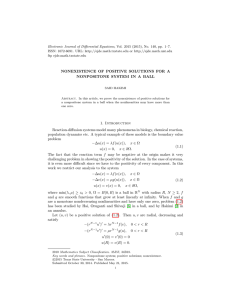Document 10841105
advertisement
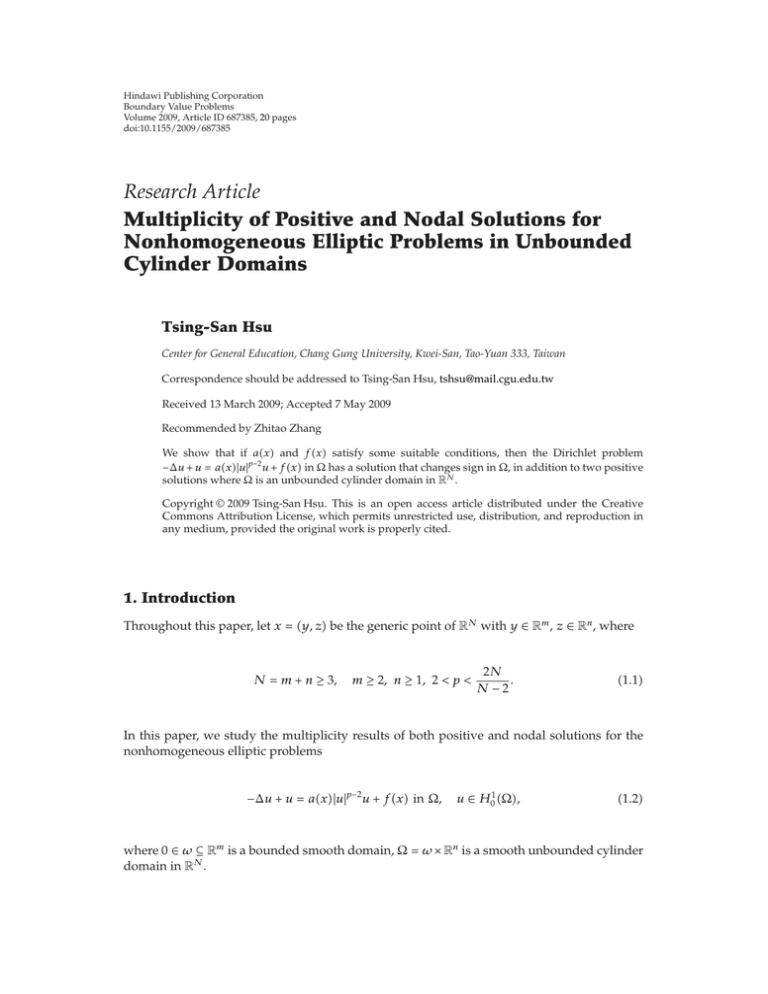
Hindawi Publishing Corporation
Boundary Value Problems
Volume 2009, Article ID 687385, 20 pages
doi:10.1155/2009/687385
Research Article
Multiplicity of Positive and Nodal Solutions for
Nonhomogeneous Elliptic Problems in Unbounded
Cylinder Domains
Tsing-San Hsu
Center for General Education, Chang Gung University, Kwei-San, Tao-Yuan 333, Taiwan
Correspondence should be addressed to Tsing-San Hsu, tshsu@mail.cgu.edu.tw
Received 13 March 2009; Accepted 7 May 2009
Recommended by Zhitao Zhang
We show that if ax and fx satisfy some suitable conditions, then the Dirichlet problem
−Δu u ax|u|p−2 u fx in Ω has a solution that changes sign in Ω, in addition to two positive
solutions where Ω is an unbounded cylinder domain in RN .
Copyright q 2009 Tsing-San Hsu. This is an open access article distributed under the Creative
Commons Attribution License, which permits unrestricted use, distribution, and reproduction in
any medium, provided the original work is properly cited.
1. Introduction
Throughout this paper, let x y, z be the generic point of RN with y ∈ Rm , z ∈ Rn , where
N m n ≥ 3,
m ≥ 2, n ≥ 1, 2 < p <
2N
.
N−2
1.1
In this paper, we study the multiplicity results of both positive and nodal solutions for the
nonhomogeneous elliptic problems
−Δu u ax|u|p−2 u fx in Ω,
u ∈ H01 Ω,
1.2
where 0 ∈ ω ⊆ Rm is a bounded smooth domain, Ω ω × Rn is a smooth unbounded cylinder
domain in RN .
2
Boundary Value Problems
It is assumed that ax and fx satisfy the following assumptions:
a1 ax is continuous and ax ∈ 0, 1 on Ω, and
lim ax 1
|z| → ∞
uniformly for y ∈ ω;
1.3
f 1 fx ≥ 0, fx /
≡ 0, fx ∈ H −1 Ω;
f 2 γf > 0 in which we defined
γf inf
1 p−1/p−2 p − 2 u2p−1/p−2
p−1
− fudx :
ax|u|p dx 1 ;
Ω
1.4
Ω
f 3 there exist positive constants C0 , 0 , R0 such that
fx ≤ C0 exp − 1 μ1 0 |z|
for |z| ≥ R0 , uniformly for y ∈ ω,
1.5
where μ1 is the first positive eigenvalue of the Dirichlet problem −Δ in ω.
For the homogeneous case, that is, fx ≡ 0, Zhu 1 has established the existence of
a positive solution and a nodal solution of problem 1.2 in H 1 RN provided ax satisfies
ax ≥ 1 in RN and ax − 1 ≥ C/|x|l as |x| → ∞ for some positive constants C and l. More
recently, Hsu 2 extended the results of Zhu 1 with RN to an unbounded cylinder Ω. Let
us recall that, by a nodal solution we mean the solution of problem 1.2 with change of sign.
For the nonhomogeneous case fx /
≡ 0, Adachi and Tanaka 3 have showed that
problem 1.2 has at least four positive solutions in H 1 RN for ax and fx satisfy some
suitable conditions, but we place particular emphasis on the existence of nodal solutions.
More recently, Chen 4 considered the multiplicity results of both positive and nodal
solutions of problem 1.2 in H 1 RN . She has showed that problem 1.2 has at least two
positive solutions and one nodal solution in H 1 RN when ax and fx satisfy some
suitable assumptions.
In the present paper, motivated by 4 we extend and improve the paper by Chen 4.
We will deal with unbounded cylinder domains instead of the entire space and also obtain
the same results as in 4. Our arguments are similar to those in 5, 6, which are based on
Ekeland’s variational principle 7.
Now, we state our main results.
Theorem 1.1. Assume a1, f1, f2 hold and ax satisfies assumption a2.
a2 there exist positive constants C, δ0 , R such that
ax ≥ 1 − C exp − 1 μ1 δ0 |z|
for |z| ≥ R,
uniformly for y ∈ ω.
1.6
Boundary Value Problems
3
Then problem 1.2 has at least two positive solutions u0 and u1 in H01 Ω. Furthermore, u0 and u1
satisfy 0 < u0 < u1 , and u0 is a local minimizer of I where I is the energy functional of problem 1.2.
Theorem 1.2. Assume a1, f1, f2, f3 hold and ax satisfies assumption a3.
a3 there exist positive constants C, R, and δ 0 < 1 μ1 such that
ax ≥ 1 C exp − 1 μ1 − δ0 |z|
for |z| ≥ R,
uniformly for y ∈ ω.
1.7
Then problem 1.2 has a nodal solution in H01 Ω in addition to two positive solutions u0 and u1 .
For the case Ω RN , we also have obtained the same results as in Theorems 1.1 and
1.2.
Theorem 1.3. Assume a1, f1, f2 hold and ax satisfies assumption a2.
a2 there exist positive constants C, δ0 , R such that
ax ≥ 1 − C exp − 1 δ0 |x|
for |x| ≥ R.
1.8
Then problem 1.2 has at least two positive solutions u0 and u1 in H 1 RN . Furthermore, u0 and u1
satisfy 0 < u0 < u1 , and u0 is a local minimizer of I where I is the energy functional of problem 1.2.
Theorem 1.4. Assume a1, f1, f2, f3 hold and ax satisfies assumption a3 below.
a3 there exist positive constants C, R and δ0 < 1 such that
ax ≥ 1 C exp − 1 − δ0 |x|
for |x| ≥ R.
1.9
Then problem 1.2 has a nodal solution in H 1 RN in addition to two positive solutions u0 and u1 .
Among the other interesting problems which are similar to problem 1.2, Bahri and
Berestycki 8 and Struwe 9 have investigated the following equation:
−Δu |u|p−2 u fx in Ω,
u ∈ H01 Ω,
1.10
where 2 < p < 2N/N − 2, f ∈ L2 Ω, and Ω is a bounded domain in RN . They found that
1.10 possesses infinitely many solutions. More recently, Tarantello 5 proved that if p 2N/N − 2 is the critical Sobolev exponent and f ∈ H −1 satisfying suitable conditions, then
1.10 admits two solutions. For the case when Ω is an unbounded domain, Cao and Zhou
10, Cı̂rstea and Rădulescu 11, and Ghergu and Rădulescu 12 have been investigated the
analogue equation 1.10 involving a subcritical exponent in RN . Furthermore, Rădulescu
and Smets 13 proved existence results for nonautonomous perturbations of critical singular
elliptic boundary value problems on infinite cones.
4
Boundary Value Problems
This paper is organized as follows. In Section 2, we give some notations and
preliminary results. In Section 3, we will prove Theorem 1.1. In Section 4, we establish the
existence of nodal solutions.
2. Preliminaries
In this paper, we always assume that Ω is an unbounded cylinder domain or RN N ≥ 3. Let
ΩR {x ∈ Ω : |z| < R} for R > 0, and let φ be the first positive eigenfunction of the Dirichlet
problem −Δ in ω with eigenvalue μ1 , unless otherwise specified. We denote by C and Ci
i 1, 2, . . . universal constants, maybe the constants here should be allowed to depend
on N and p, unless some statement is given. Now we begin our discussion by giving some
definitions and some known results.
We define
u Ω
uq Ω
1/2
,
|∇u|2 u2 dx
|u|q dx
1/q
,
1 ≤ q < ∞,
2.1
u∞ sup|ux|.
x∈Ω
Let H01 Ω be the Sobolev space of the completion of C0∞ Ω under the norm · with the
dual space H −1 Ω, H 1 RN H01 RN and denote ·, · the usual scalar product in H01 Ω.
The energy functional of problem 1.2 is given by
Iu 1
2
1
ax|u|p − fu,
|∇u|2 u2 −
p
2.2
here and from now on, we omit “dx” and “Ω” in all the integration if there is no other
indication. It is well known that I is of C1 in H01 Ω and the solutions of problem 1.2 are the
critical points of the energy functional I see Rabinowitz 14.
As the energy functional I is not bounded on H01 Ω, it is useful to consider the
functional on the Nehari manifold
N u ∈ H01 Ω \ {0} : I u, u 0 .
2.3
Thus, u ∈ N if and only if
I u, u u2 −
p
ax|u| −
fu 0.
2.4
Easy computation shows that I is bounded from below in the set N. Note that N contains
every nonzero solution of 1.2.
Boundary Value Problems
5
Similarly to the method used in Tarantello 5, we split N into three parts:
N u ∈ N : u2 − p − 1
ax|u|p > 0 ,
2
N u ∈ N : u − p − 1
ax|u|p 0 ,
0
2.5
2
N u ∈ N : u − p − 1
ax|u|p < 0 .
−
Let us introduce the problem at infinity associated with problem 1.2 as
−Δu u |u|p−2 u in Ω,
u ∈ H01 Ω, u > 0 in Ω.
2.6
We state here some known results for problem 2.6. First of all, we recall that by Esteban 15
and Lien et al. 16, problem 2.6 has a ground state solution w such that
∞
∞
∞
S I w supI tw t≥0
1 1
−
Sp/p−2 ,
2 p
2.7
where I ∞ u 1/2u2 − 1/p |u|p , S∞ inf{I ∞ u : u ∈ H01 Ω, u ≡
/ 0, I ∞ u 0} and
S inf
2
|∇u| u
2
:u∈
H01 Ω,
|u| 1 .
p
2.8
Furthermore, from Hsu 2 we can deduce that for any ∈ 0, 1μ1 there exist positive
such that, for all x y, z ∈ Ω,
constants C , C
C φ y exp − 1 μ1 |z| ≤ wx ≤ C φ y exp − 1 μ1 − |z| .
2.9
We also quote the following lemma see Hsu 17 or K.-J. Chen et al. 18 for the proof about
the decay of positive solution of problem 1.2 which we will use later.
Lemma 2.1. Assume a1, f1 and f3 hold. If u ∈ H01 Ω is a positive solution of problem 1.2,
then
i u ∈ Lq Ω for all q ∈ 2, ∞;
ii uy, z → 0 as |z| → 0 uniformly for y ∈ ω and u ∈ C1,α Ω for any 0 < α < 1;
iii for any ∈ 0, 1 μ1 , there exist positive constants c , c such that, for all x y, z ∈ Ω,
c φ y exp − 1 μ1 |z| ≤ ux ≤ c φ y exp − 1 μ1 |z| .
We end this preliminaries by the following definition.
2.10
6
Boundary Value Problems
Definition 2.2. Let c ∈ R, E be a Banach space and I ∈ C1 E, R.
i {un } is a P Sc -sequence in E for I if Iun c o1 and I un o1 strongly in
E−1 as n → ∞.
ii We say that I satisfies the P Sc condition if any P Sc -sequence {un } in E for I has
a convergent subsequence.
3. Proof of Theorem 1.1
In this section, we will establish the existence of two positive solutions of problem 1.2.
First, we quote some lemmas for later use see the proof of Tarantello 5 or Chen 4,
Lemmas 2.2, 2.3, and 2.4.
≡ 0, there exists a unique
Lemma 3.1. Assume a1 and f1 hold, then for every u ∈ H01 Ω, u /
t− t− u > 0 such that t− u ∈ N− . In particular, we have
−
t >
u2
p − 1 ax|u|p
and It− u maxt≥tmax Itu. Moreover, if
that t u ∈ N . In particular,
1/p−2
tmax
3.1
fu > 0, then there exists a unique t t u > 0 such
t < tmax ,
3.2
It u min0≤t≤tmax Itu and It− u maxt≥0 Itu.
Lemma 3.2. Assume a1, f1 and f2 hold, then for every u ∈ N \ {0}, we have
u2 − p − 1
ax|u|p / 0 i.e., N0 {0}.
3.3
Lemma 3.3. Assume a1, f1 and f2 hold, then for every u ∈ N \ {0}, there exist a > 0 and a
C1 -map t tw > 0, w ∈ H01 Ω, w < satisfying that
t0 1,
twu − w ∈ N,
for w < ,
2 ∇u∇w uw − p ax|u|p−2 uw − fw
.
t 0, w u2 − p − 1 ax|u|p
3.4
Apply Lemmas 3.1, 3.2, 3.3, and Ekeland variational principle 7, and we can establish
the existence of the first positive solution.
Proposition 3.4. Assume a1, f1 and f2 hold, then the minimization problem c0 infN I infN I is achieved at a point u0 ∈ N which is a critical point for I. Moreover, if fx ≥ 0 and
fx /
≡ 0, then u0 is a positive solution of problem 1.2 and u0 is a local minimizer of I.
Boundary Value Problems
7
Proof. Modifying the proof of Chen 4, Proposition 2.5. Here we omit it.
Since u0 ∈ N and c0 infN I infN I, thus, in the search of our second positive
solution, it is natural to consider the second minimization problem:
c1 inf− I.
3.5
N
We will establish the existence of the second positive solution of problem 1.2 by proving
that I satisfies the P Sc1 -condition.
Proposition 3.5. Assume a1, f1 and f2 hold, then I satisfies the P Sc -condition with c ∈
−∞, c0 S∞ .
Proof. Let {un } be a P Sc -sequence for I with c ∈ −∞, c0 S∞ . It is easy to see that {un }
is bounded in H01 Ω, so we can find a u ∈ H01 Ω such that un u weakly in H01 Ω up to
a subsequence and u is a critical point of I. Furthermore, we may assume un → u a.e. in Ω,
un → u strongly in Lsloc Ω for all 1 ≤ s < 2N/N − 2. Hence we have that I u 0 and
fun fu o1.
3.6
Set vn un − u. Then by 3.6 and Brézis and Lieb lemma see 19, we obtain
Iun 1
1
un 2 −
2
p
ax|un |p −
1
1
Iu vn 2 −
2
p
fun
3.7
p
ax|vn | o1.
Moreover, by Vitali’s lemma and I u 0,
o1 I un , un
2
p
2
u − ax|u| − fu vn − ax|vn |p o1
I u, u vn 2 −
ax|vn |p o1
2
vn −
ax|vn |p o1.
3.8
8
Boundary Value Problems
In view of assumptions Iun c o1, and 3.7, 3.8, u ∈ N and by Lemma 3.2, we obtain
1
1
2
ax|vn |p o1,
c ≥ c0 vn −
2
p
2
vn − ax|vn |p o1.
3.9
3.10
Hence, we may assume that
vn 2 −→ b,
ax|vn |p −→ b.
3.11
By the definition of S, we have vn 2 ≥ Svn 2p , combining with 3.11 and a∞ 1, and we
get that b ≥ Sb2/p . Either b 0 or b ≥ Sp/p−2 . If b 0, the proof is complete. Assume that
b ≥ Sp/p−2 , from 2.7, 3.9, and 3.11, we get
c ≥ c0 1 1
1 1
−
b ≥ c0 −
Sp/p−2 ≥ c0 S∞ ,
2 p
2 p
3.12
which is a contradiction. Therefore, b 0 and we conclude that un → u strongly in H01 Ω.
Let eN 0, 0, . . . , 0, 1 ∈ RN , let en 0, 0, . . . , 0, 1 ∈ Rn , and let k > 0 be a constant,
we denote wk x wx − keN and uk x u0 x keN for x ∈ Ω where w is the ground
state solution of problem 2.6 and u0 is the first positive solution of problem 1.2.
Proposition 3.6. Assume a1, a2 and f1 hold, then there exists k0 ≥ 1 such that
Iu0 twk0 < c0 S∞ ,
∀ t > 0.
3.13
The following estimates are important to find a path which lies below the first level of
the break down of the P Sc condition. Here we use an interaction phenomenon between u0
and wk0 .
To give a proof of Proposition 3.6, we need to establish some lemmas.
Lemma 3.7. Let B1 {x y, z ∈ Ω : y ∈ ω0 , |z| ≤ 1}, and ω0 ⊂⊂ ω is a domain in Rm . Then for
any ∈ 0, 1 μ1 , there exists a positive constant C1 such that
uk x ≥ C1 e−
B1
√
1μ1 k
,
∀ k ≥ 1.
3.14
Boundary Value Problems
9
Proof. From 2.10, we have for k ≥ 1,
ux keN uk x B1
B1
√
c φ y e− 1μ1 |zkeN |
≥
B1
≥ c e−
√
≥ C1 e−
1μ1 k1
3.15
φ y
B1
√
1μ1 k
.
Lemma 3.8. Let Θ be a domain in Rn , and let z z1 , z2 , . . . , zn be a vector in Rn . If g : Θ → R
satisfies
gzeσ|z| dz < ∞ for some σ > 0,
3.16
Θ
then
Θ
gze−σ|zken | dz eσk gze−σzn dz o1
as k −→ ∞,
3.17
gze−σ|z−ken | dz eσk gzeσzn dz o1
as k −→ ∞.
3.18
Θ
or
Θ
Θ
Proof. We know σ|ken | ≤ σ|z| σ|z ken |, then
gze−σ|zken | eσ|ken | ≤ gzeσ|z| .
3.19
Since −σ|z ken | σ|ken | −σz, ken /|ken | o1 −σzn o1 as k → ∞, the lemma
follows from the Lebesgue’s dominated convergence theorem.
Now, we give the proof of Proposition 3.6.
The Proof of Proposition 3.6
Recall B1 {x y, z ∈ Ω | y ∈ ω0 , |z| ≤ 1}, where ω0 ⊂⊂ ω is a domain in Rm . For k ≥ 1, let
Dk {x ∈ Ω : x − keN ∈ B1 },
r min wk x min wx > 0.
x∈Dk
x∈B1
3.20
10
Boundary Value Problems
We also remark that for all s > 0, t > 0,
s tp − sp − tp − psp−1 t ≥ 0,
3.21
and for any s0 > 0 and r0 > 0 there exists C2 s0 , r0 > 0 such that for all s ∈ 0, r0 , t ∈ s0 , r0 ,
s tp − sp − tp − psp−1 t ≥ C2 s0 , r0 st.
3.22
Since I is continuous in H01 Ω, there exists t1 > 0 such that for all t ∈ 0, t1 ,
Iu0 twk < Iu0 I ∞ w,
∀ k ≥ 0,
3.23
and by the fact that Iu0 twk → −∞ as t → ∞ uniformly in k ≥ 1, then there exists t0 > 0
such that
supIu0 twk sup Iu0 twk .
t≥0
3.24
0≤t≤t0
Thus, we only need to show that there exists a constant k0 ≥ 1 such that
sup Iu0 twk < Iu0 I ∞ w,
t1 ≤t≤t0
∀ k ≥ k0 .
3.25
Straightforward computation gives us
Iu0 twk t2
t2
1
u0 2 wk 2 u0 , twk −
2
2
p
− fu0 − t fwk
ax|u0 twk |p
Iu0 I ∞ twk 1 p
p
p
∞
−
ax|u0 twk | − ax|u0 | − a |twk | t ax|u0 |p−1 wk
p
∞
Iu0 I tw
1
−
ax |u0 twk |p − |u0 |p − |twk |p − p|u0 |p−1 twk
p
1 ∞
a |twk |p − ax|twk |p
p
≤ c0 S∞ − I II,
3.26
Boundary Value Problems
11
where
1
I p
ax |u0 twk |p − |u0 |p − |twk |p − p|u0 |p−1 twk ,
1
II p
3.27
∞
p
a − ax|twk | .
Thus, we only need to prove that there exists a constant k0 ≥ 1 such that
−I II < 0,
∀ t ∈ t1 , t0 .
3.28
Now we estimate I and II. Without loss of generality, we may assume that δ0 < p2 −
11 μ1 . Thus, we can choose 0 small enough such that
p 1 μ1 − 0 > 1 μ1 δ0 .
3.29
By 3.21,
1
I p
1
≥
p
ax |u0 twk |p − |u0 |p − |twk |p − p|u0 |p−1 twk
p
p
p
ax |u0 twk | − |u0 | − |twk | − p|u0 |
p−1
3.30
twk .
Dk
Let a0 infx∈Ω ax > 0, s0 t1 minx∈Dk wk x, r0 max{maxx∈Ω u0 x, t0 maxx∈Ω wx} > 0
and by applying 3.22, we obtain
I ≥
a0
p
C2 s0 , r0 tu0 wk
Dk
a0
≥ C2 s0 , r0 t1
p
3.31
∀ t ∈ t1 , t0 .
uk w
x∈B1
Let δ0 /2. Then applying 3.14, we have for A a0 /pC1 δ0 /2C2 s0 , r0 t1 minx∈B1 wx
I ≥ Ae−
√
1μ1 δ0 /2k
.
3.32
12
Boundary Value Problems
Next from a2, 2.9, 3.29, and Lemma 3.8, there exists a k1 such that for any k ≥ k1 ,
1
II p
a∞ − ax|twk |p
1
p
≤
t0 ∞
a a∞ p
a∞ − ax|twk |p ΩR
p
p
t
0
p
Ω\ΩR
1
p
Ω\ΩR
a∞ − ax|twk |p
√
p
C0 φp y e−p 1μ1 −0 |z−ken |
ΩR
3.33
√
√
p
CC0 φp y e− 1μ1 δ0 |z| e−p 1μ1 −0 |z−ken |
p
√
√
t0
p
CC0 φp y dy
e− 1μ1 δ0 |zken | e−p 1μ1 −0 |z| dz
p
ω
Rn
√
√
≤ C3 e−p 1μ1 −0 k C4 e− 1μ1 δ0 k .
≤ C3 e−p
√
1μ1 −
0 k
From 3.29, we have for B 2 max{C3 , C4 },
II ≤ Be−
√
1μ1 δ0 k
3.34
.
Finally, we can choose k0 ≥ k1 large enough such that
Be−
√
1μ1 δ0 k
< Ae−
√
1μ1 δ0 /2k
,
∀ k ≥ k0 .
3.35
Thus from 3.26 and 3.32–3.35, we obtain 3.13. This completes the proof of
Proposition 3.6.
Proposition 3.9. For c1 infN− I, there exists a P Sc1 -sequence {un } ⊂ N− for I. In particular, we
have c1 < c0 S∞ .
Proof. Set Σ {u ∈ H01 Ω : u 1} and define the map Ψ : Σ → N− given by Ψu t− uu. Since the continuity of t− u follows immediately from its uniqueness and extremal
property, thus Ψ is continuous with continuous inverse given by Ψ−1 u u/u. Clearly N−
disconnecting H01 Ω is exactly two components:
u
u
u
,
U2 u : u > t−
u
U1 and N ⊂ U1 .
u 0 or u : u < t−
,
3.36
Boundary Value Problems
13
We will prove that there exists t0 such that u0 t0 wk0 ∈ U2 . Denote t1 t− u0 twk0 /u0 twk0 . Since t− u0 twk0 /u0 twk0 u0 twk0 /u0 twk0 ∈ N− , we have
p
t21
−
t1
ax|u0 twk0 |p
u0 twk0 p
t1
u0 twk0 fu0 twk0 ≥ 0.
3.37
Thus
t1 ≤ ≤ ax|u0 twk0 |p
u0 /t wk0 ax|u0 /t wk0 |p
p/p−2
1/p
p/p−2
a0 |u0 /t wk0 |p
wk0 < ∞
1/p
u0 /t wk0 1/p−2
−→ a0
p/p−2
u0 twk0 where a0 infΩ ax > 0
1/p
3.38
as t −→ ∞.
Therefore, there exists t2 > 0 such that t1 t− u0 twk0 /u0 twk0 < wk0 , for t ≥ t2 . Since
t0 > t2 1, then
2
2
t20 wk0 2
2
t20 wk0 2
u0 t0 wk0 u0 2t0
∇u0 ∇wk0 u0 wk0 u0 2t0
|wk0 |p−1 u0
3.39
> t20 wk0 2 > wk0 2 > t21 ,
hence u0 t0 wk0 ∈ U2 .
N− disconnects H01 Ω in exactly two components, so we can find an s ∈ 0, 1 such
that u0 st0 wk0 ∈ N− . Therefore c1 ≤ Iu0 st0 wk0 < c0 S∞ , which follows from
Proposition 3.6.
Analogously to the proof of Proposition 3.4, by the Ekeland variational principle we
can show that there exists a P Sc1 -sequence {un } ⊂ N− for I.
Proposition 3.10. Assume a1, a2, f1 and f2 hold, then the functional I has a minimizer
u1 ∈ N− which is also a critical point of I and u1 > 0 for f ≥ 0, f ≡
/ 0.
Proof. From Propsitions 3.5 and 3.9, we can deduce that un → u1 strongly in H01 Ω.
Consequently, u1 is a critical point of I, u1 ∈ N− since N− is closed and Iu1 c1 .
By Lemma 3.1, we can choose a number t− |u1 | > 0 such that t− |u1 ||u1 | ∈ N− . Since
u1 ∈ N− , t− u1 1. Applying Lemma 3.1 again, we conclude that
t− |u1 | ≥ tmax |u1 | tmax u1 ,
c1 Iu1 max Itu1 ≥ I t− |u1 |u1 ≥ I t− |u1 ||u1 | ≥ c1 .
t≥tmax u1 3.40
14
Boundary Value Problems
Hence It− |u1 |u1 c1 . So we can always take u1 ≥ 0. By the maximum principle for weak
solutions see Gilbarg and Trudinger 20 we can show that if f ≥ 0, f /
≡ 0, then u1 > 0 in
Ω.
The proof of Theorem 1.1
By Propositions 3.4 and 3.10, we obtain the conclusion of Theorem 1.1.
4. Existence of Nodal Solution
In this section, we will study the existence of nodal solutions for problem 1.2. To this end,
we need to compare some different minimization problems. Define
N−1 u u − u− ∈ N : u ∈ N− ,
N−2 u u − u− ∈ N : −u− ∈ N− .
4.1
Here, we use notation u± max{±u, 0}. Set
β1 inf− Iu,
4.2
β2 inf− Iu.
4.3
u∈N1
u∈N2
Then we have
Proposition 4.1. (a) If β1 < c1 , then the minimization problem 4.2 attains its infimum at a point
which defines a sign changing critical point of I. (b) Analogously, if β2 < c1 the same conclusion holds
for the minimization problem 4.3.
Proof. The proof is almost the same as that in Tarantello 6, Proposition 3.1 .
The above proposition would yield the conclusion for the main theorem only if the
given relations between β1 , β2 , and c1 could be established. While it is not clear whether or not
such inequalities should hold, we will use these values to compare with another minimization
problem. Namely, set
N−∗ N−1 ∩ N−2 u u − u− ∈ N : u , −u− ∈ N− ⊂ N−
4.4
c2 inf− Iu.
4.5
and define
u∈N∗
It is clear that c2 ≥ c1 . Since I satisfies P Sc condition only locally, we need the following
upper bound for c2 . Recall that eN 0, 0, . . . , 0, 1 ∈ RN , en 0, 0, . . . , 0, 1 ∈ Rn and wk x wx − keN where k > 1 and w is the ground state solution of problem 2.6.
Boundary Value Problems
15
Lemma 4.2. Assume a1, a3 and f1–f3 hold. For any fixed k > 1, there exist s > 0, t > 0
such that
su1 − twk ∈ N−∗ ,
4.6
c2 < supIsu1 − twk < c1 S∞ .
4.7
and for k large,
s,t≥0
Proof. To prove 4.6, it suffices to show that there exist s > 0 and t > 0 such that
su1 − twk ∈ N− ,
su1 − twk − ∈ N− .
4.8
To this purpose, let
t1 min
Ω
u1
,
wk
t2 max
Ω
u1
.
wk
4.9
For t ∈ t1 , t2 , denote by s t and s− t the positive values given by Lemma 3.1 according to
which we have
s tu1 − twk ∈ N− ,
−s− tu1 − twk − ∈ N− .
4.10
Note that s t and s− t are continuous with respect to t satifying
lim s t t u1 − t1 wk < ∞,
t → t1
lim s− t ∞,
t → t1
lim s t ∞,
t → t−2
lim− s− t t −u1 − t2 wk − < ∞.
4.11
t → t2
Therefore, by the continuity of s± t, we can find t0 ∈ t1 , t2 such that s t0 s− t0 s0 > 0.
This gives 4.8 with t t0 and s s0 .
To prove 4.7, we only need to estimate Isu1 − twk for s ≥ 0 and t ≥ 0. First, it is
obvious that the structure of I guarantees the existence of r0 > 0 independent of k large
such that Isu1 − twk ≤ c1 < c1 S∞ , for all s2 t2 ≥ r02 . On the other hand, for s2 t2 ≤ r02 ,
since I is continuous in H01 Ω, there exists t ∈ 0, r0 small enough such that
Isu1 − twk < Iu1 I ∞ w c1 S∞ ,
∀ s2 t2 ≤ r02 , t < t.
4.12
16
Boundary Value Problems
At this point, we find large k0 ≥ 1, such that Isu1 − twk < c1 S∞ holds for all s2 t2 ≤ r02
and t ≥ t:
1
1
ax|su1 − twk |p − fsu1 − twk su1 − twk 2 −
2
p
1
1
1
1
p
p
2
2
ax|su1 | − fsu1 |twk |
su1 −
twk −
2
p
2
p
1 ax|su1 − twk |p − ax|su1 |p − |twk |p
− st ∇u1 ∇wk u1 wk −
p
ftwk
Isu1 − twk ∞
Isu1 I twk − st
1
−
p
p−1
u1 w k
∞
p
ax − a |twk | t
1
p
ax |su1 |p |twk |p − |su1 − twk |p
ftwk .
4.13
By 4.13 and the following elementary inequality:
α βp ≥ |α|p βp − C5 |α|p−1 β |α|βp−1 ,
∀ α, β ∈ R, p > 1,
4.14
where C5 is some positive constant, we have
sup
Isu1 − twk s2 t2 ≤r02 , s≥0, t≥t
sup
Isu1 − twk 0≤s≤r0 , t≤t≤r0
≤ supIsu1 supI ∞ twk s≥0
p
−
t
p
t≥0
p
ax − a∞ wk r0
a∞
p−1
C5 r0
p
p−1
p−1
u1 wk u1 wk
fwk .
4.15
Without loss of generality, we may assume R0 R, and ∈ 0, δ 0 where R0 , R and δ0
are given in f3 and a3, respectively.
Boundary Value Problems
17
i First, by the Hölder inequality and 2.9,
ΩR0
p−1
u1 w k
≤
p
u1
ΩR0
p−1/p ΩR0
≤ C6
1/p
p
wk
1/p
−p√1μ1 −|zken |
φ y e
dy dz
p
{z:|z|≤R0 }
ω
≤ C7 e−
√
1μ1 −k
4.16
.
From 2.9, 2.10, and applying Lemma 3.8, there exists a k1 such that for k ≥ k1
Ω\R0
p−1
u1 w k
≤ C8
{z:|z|≥R0 }
≤ C9 e−
e−p−1
√
√
1μ1 −|z| −
e
√
1μ1 −|zken |
dz
4.17
1μ1 −k
.
Similarly, we also obtain
wk u1 ≤ C10 e−p−1
p−1
ΩR0
√
p
1μ1 −k
|ax − a∞ |wk ≤ C11 e−p
ΩR0
ΩR0
√
,
1μ1 −k
4.18
,
√
fxwk ≤ C12 e− 1μ1 −k ,
and there exists a k2 ≥ k1 such that for k ≥ k2
p−1
Ω\R0
wk u1 ≤ C13 e−
√
1μ1 −k
4.19
.
ii Since ax satisfies assumption a3 and by Lemma 3.8, there exists a k3 ≥ k2 such
that for k ≥ k3 ,
p
Ω\ΩR0
ax − a∞ wk ≥ C14 e−
1μ1 −δ0 k
4.20
.
By f3, 2.9, and Lemma 3.8, there exists a k4 ≥ k3 such that for k ≥ k4 ,
Ω\R0
fwk ≤ C10
{z:|z|≥R0 }
≤ C11 e−
√
e−
1μ1 −k
√
1μ1 0 |z| −
e
√
1μ1 −|zken |
dz
4.21
.
18
Boundary Value Problems
iii Note that the constants Ci 5 ≤ i ≤ 11 in i, ii are independent of k. Thus, by i,
ii, 2 < p < 2N/N − 2 and let δ0 /2, we can find a k0 ≥ k4 such that for k ≥ k0 ,
a∞
p−1
C5 r0
p
p−1
u1 wk
p−1
u1 wk
p
t
−
p
∞
ax − a
p
wk
r0
fwk < 0.
4.22
Combining 4.15 and 4.22, we obtain that there exists a k0 ≥ k4 such that for
k ≥ k0 ,
Isu1 − twk < supIsu1 supI ∞ twk c1 S∞ .
sup
s≥0
s2 t2 ≤r02 , s≥0, t≥t
4.23
t≥0
This completes the proof of Lemma 4.2.
Proposition 4.3. Assume a1, a2, f1 and f2 hold. If β1 ≥ c1 and β2 ≥ c1 , then the
minimization problem c2 infN−∗ Iu attains its infimum at u2 ∈ N−∗ which defines a changing
sign critical point of I.
Proof. It is obvious that N−∗ is closed. Exactly as in the proof of 6, Proposition 3.2, by means
of Ekeland’s principle, we derive a P Sc2 -sequence {un } ⊂ N−∗ for I. In particular, we have
0 < b1 ≤ u±n ≤ b2 , for some constants b1 and b2 . Thus, we can take a subsequence, also
denoted by {un }, such that u±n u± weakly in H01 Ω. We start by showing that u± ≡
/ 0.
Indeed, if by contradiction we assume, for instant, that u ≡ 0, then we can deduce
that
p
2
4.24
un − ax|un | o1.
On the other hand,
Iun 1
1
2
un −
2
p
p
ax|un |
−
fun
1
1
2
un −
2
p
ax|un | o1.
p
4.25
By 4.24 and un ≥ b1 > 0, we may assume that
un −→ b,
2
ax|un | −→ b.
p
4.26
Using the argument in the proof of Proposition 3.5, by 2.7, 4.24, and 4.25, we can deduce
that b ≥ Sp/p−2 and
Iun 1 1
1 1
−
b o1 ≥
−
Sp/p−2 o1 S∞ o1.
2 p
2 p
4.27
However, by Lemma 4.2, Iun c2 − I−u−n o1 ≤ c2 − c1 o1; that is, limn → ∞ Iun c2 −
≡0
c1 < S∞ which contradicts 4.27. A similar argument applies to u− . Therefore, u2 u − u− /
is a weak solution of problem 1.2 changing sign and u2 ∈ N, Iu2 ≥ c0 .
Boundary Value Problems
19
Set un u vn and u−n u− vn− with vn± 0 weakly in H01 Ω. Note that
± 2
vn −
p
axvn± o1.
4.28
In view of Proposition 3.9 and Lemma 4.2, we also have
lim Ivn I vn− lim Ivn lim Iun − Iu2 n→∞
n→∞
n→∞
≤ c2 − c0 < c1 S∞ − c0 < 2S∞ .
4.29
Therefore, we must have
min lim Ivn , lim I −vn−
< S∞ .
n→∞
n→∞
4.30
Without loss of generality, we suppose
lim Ivn < S∞ .
4.31
n→∞
By 4.24, we have
Ivn 1 2 1
v −
2 n
p
ax|vn | o1.
p
4.32
We claim that limn → ∞ vn 2 0. Indeed, we assume {vn } is bounded below, as above, 4.28
and 4.32 imply Ivn ≥ S∞ o1, contradicting 4.31. In the same way, if limn → ∞ I−vn− <
S∞ , we can also prove limn → ∞ vn− 2 0. Hence we have limn → ∞ vn 2 0 or limn → ∞ vn− 2 0; that is, u2 u − u− ∈ N−1 or u2 u − u− ∈ N−2 . By assumptions β1 ≥ c1 and β2 ≥ c2 , we
conclude that Iu2 ≥ c1 .
If we write un u2 wn with wn 0 weakly in H01 Ω, we have
2
wn −
ax|wn |p o1,
1
1
2
ax|wn |p
lim Iun − Iu2 lim
wn −
n→∞
n→∞ 2
p
1 1
−
lim
wn 2 .
n→∞ 2
p
4.33
Furthermore, by Lemma 4.2, we have
lim Iun − Iu2 c2 − Iu2 ≤ c2 − c1 < S∞ .
n→∞
4.34
20
Boundary Value Problems
We claim that limn → ∞ wn 2 0. Indeed, we assume {wn } is bounded below, as above, 4.33
imply Iwn ≥ S∞ o1, contradicting 4.34. Consequently, un → u2 strongly in H01 Ω and
Iu2 c2 .
The Proof of Theorems 1.2–1.4
The conclusion of Theorem 1.2 follows immediately from Theorem 1.2 and Propositions 4.1
and 4.3. With the same argument, we also have that Theorems 1.3 and 1.4 hold for Ω RN .
References
1 X. P. Zhu, “Multiple entire solutions of a semilinear elliptic equation,” Nonlinear Analysis: Theory,
Methods & Applications, vol. 12, no. 11, pp. 1297–1316, 1988.
2 T.-S. Hsu, “Multiple solutions for semilinear elliptic equations in unbounded cylinder domains,”
Proceedings of the Royal Society of Edinburgh. Section A, vol. 134, no. 4, pp. 719–731, 2004.
3 S. Adachi and K. Tanaka, “Four positive solutions for the semilinear elliptic equation: −Δu u αxup fx in RN ,” Calculus of Variations and Partial Differential Equations, vol. 11, no. 1, pp. 63–95,
2000.
4 K.-J. Chen, “Multiplicity of positive and nodal solutions for an inhomogeneous nonlinear elliptic
problem,” Nonlinear Analysis: Theory, Methods & Applications, vol. 70, no. 1, pp. 194–210, 2009.
5 G. Tarantello, “On nonhomogeneous elliptic equations involving critical Sobolev exponent,” Annales
de l’Institut Henri Poincaré. Analyse Non Linéaire, vol. 9, no. 3, pp. 281–304, 1992.
6 G. Tarantello, “Multiplicity results for an inhomogeneous Neumann problem with critical exponent,”
Manuscripta Mathematica, vol. 81, no. 1-2, pp. 57–78, 1993.
7 I. Ekeland, “On the variational principle,” Journal of Mathematical Analysis and Applications, vol. 47, pp.
324–353, 1974.
8 A. Bahri and H. Berestycki, “A perturbation method in critical point theory and applications,”
Transactions of the American Mathematical Society, vol. 267, no. 1, pp. 1–32, 1981.
9 M. Struwe, “Infinitely many critical points for functionals which are not even and applications to
superlinear boundary value problems,” Manuscripta Mathematica, vol. 32, no. 3-4, pp. 335–364, 1980.
10 D.-M. Cao and H.-S. Zhou, “Multiple positive solutions of nonhomogeneous semilinear elliptic
equations in RN ,” Proceedings of the Royal Society of Edinburgh. Section A, vol. 126, no. 2, pp. 443–463,
1996.
11 F. Cı̂rstea and V. Rădulescu, “Multiple solutions of degenerate perturbed elliptic problems involving
a subcritical Sobolev exponent,” Topological Methods in Nonlinear Analysis, vol. 15, no. 2, pp. 283–300,
2000.
12 M. Ghergu and V. Rădulescu, “Singular elliptic problems with lack of compactness,” Annali di
Matematica Pura ed Applicata, vol. 185, no. 1, pp. 63–79, 2006.
13 V. Rădulescu and D. Smets, “Critical singular problems on infinite cones,” Nonlinear Analysis: Theory,
Methods & Applications, vol. 54, no. 6, pp. 1153–1164, 2003.
14 P. H. Rabinowitz, Minimax Methods in Critical Point Theory with Applications to Differential Equations,
vol. 65 of CBMS Regional Conference Series in Mathematics, American Mathematical Society,
Washington, DC, USA, 1986.
15 M. J. Esteban, “Nonlinear elliptic problems in strip-like domains: symmetry of positive vortex rings,”
Nonlinear Analysis: Theory, Methods & Applications, vol. 7, no. 4, pp. 365–379, 1983.
16 W. C. Lien, S. Y. Tzeng, and H. C. Wang, “Existence of solutions of semilinear elliptic problems on
unbounded domains,” Differential and Integral Equations, vol. 6, no. 6, pp. 1281–1298, 1993.
17 T.-S. Hsu, “Existence of multiple positive solutions of subcritical semilinear elliptic problems in
exterior strip domains,” Nonlinear Analysis: Theory, Methods & Applications, vol. 64, no. 6, pp. 1203–
1228, 2006.
18 K.-J. Chen, K.-C. Chen, and H.-C. Wang, “Symmetry of positive solutions of semilinear elliptic
equations in infinite strip domains,” Journal of Differential Equations, vol. 148, no. 1, pp. 1–8, 1998.
19 H. Brézis and E. Lieb, “A relation between pointwise convergence of functions and convergence of
functionals,” Proceedings of the American Mathematical Society, vol. 88, no. 3, pp. 486–490, 1983.
20 D. Gilbarg and N. S. Trudinger, Elliptic Partial Differential Equations of Second Order, vol. 224 of
Grundlehren der Mathematischen Wissenschaften, Springer, Berlin, Germany, 2nd edition, 1983.
